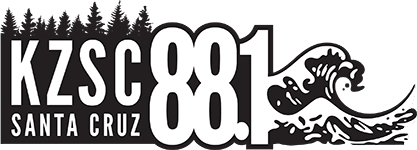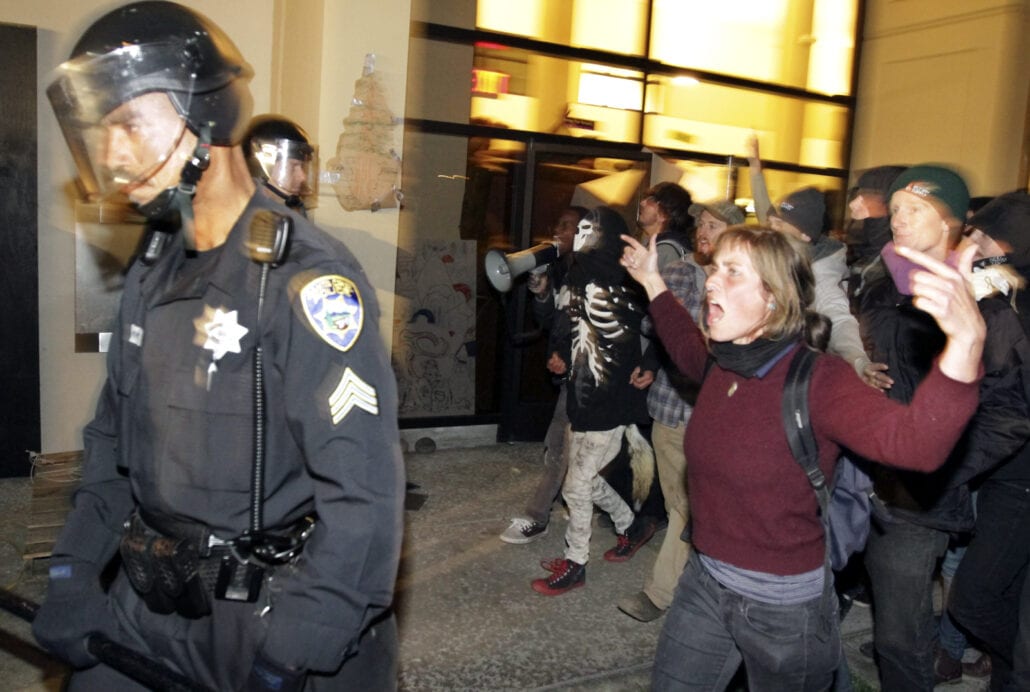
Photo by Shmuel Thaler/Santa Cruz Sentinel
By John Malkin
The following story is condensed from three hours of interviews and was originally published in the Santa Cruz Sentinel in two parts on December 1st and 2nd, 2021. The interviews were originally broadcast on “Transformation Highway” on KZSC during December, 2021.
Ten years ago – on November 30th, 2011 – a group of activists with Occupy Santa Cruz marched across the Water Street Bridge and occupied a vacant bank for three days. They hoped to call attention to the crises of homelessness, mass foreclosures of homes and the system of economic inequality perpetuated by “the 1%” – a term coined by Occupy activists that remains in the popular vernacular.
The occupied bank was purchased by San Francisco-based Wells Fargo in 2008 and had housed Coast Commercial Bank, part of Greater Bay Bank. Years later, in 2020, Wells Fargo would be forced to pay a $3 billion settlement when it was discovered they’d created millions of fake bank accounts to increase sales.
When the Nov. 30th, 2011 Santa Cruz Occupy march reached the vacant bank at 75 River Street the front door was already unlocked and a large group walked in. The entrance was quickly barricaded with furniture and that evening police in riot gear faced off with a handful of people remaining inside. Surprisingly, the officers were forced to retreat.
Over the next three days one of the most unusual experiments in local direct action played out in the occupied bank. Six months later arrests were made and court hearings began for eleven Santa Cruz activists plucked out of hundreds who’d entered the bank while it was occupied. Visitors had included City Councilmember Katherine Beiers, City Manager Martin Bernal and journalists and on the second night, hundreds of rambunctious party-goers. The Santa Cruz 11 were accused of trespassing, vandalism and conspiracy, felonies that could’ve brought years in prison.
Interview with Brent Adams
Interview with Penske Pocket
Interview with Grant Wilson

Photo by Shmuel Thaler/Santa Cruz Sentinel
MASSIVE INEQUITY
One of the Santa Cruz 11 was Brent Adams, who was active at the Occupy encampment at San Lorenzo Park and the County government building. He was also producing a documentary about the local movement. Four hours after the vacant bank became occupied Adams stood inside the red brick building (then renting for $28K/month) at one of the teller windows and did an interview with a camera person he’d brought along. In the video Adams calmly explains, “Today we are occupying 75 River Street, a former bank location. We’re making the case that the mortgage debacle, the housing crisis, all of the people who are homeless, and all the houses that have been foreclosed on all over the country are a travesty and a massive inequity in our society… This bank has been vacant for three years and we gained entrance without damaging anything and we’re peacefully occupying the space… We realized we could, and should, re-purpose it as a community center that could serve our very large homeless population.”
Ten years later Adams looks back and remembers, “The march wound past this bank building and the doors were already unlocked. And there we were, inside the building. And the police were caught surprised, which showed that they hadn’t infiltrated the group very closely.” Adams, now 58 years old, adds, “Being in there was very exciting. I videotaped the whole thing. I had a camera person there so I could do what I needed to do. I had a particular role of moving furniture and helping secure the space.”
At the time, County Supervisor Zach Friend was spokesperson for the Santa Cruz Police Department and offered regular soundbites to media on the local Occupy movement. As in other cities, activists and homeless in Santa Cruz had established camps in “the commons.” Over one hundred people were living together in San Lorenzo Park and holding regular General Assembly meetings on the steps of the County building. Police and city government had been negotiating with Occupy activists and when the vacant bank was occupied Friend told local media point blank, “This is just not part of the deal… We see it as a significant escalation from their previous commitments.”
Recently Supervisor Friend declined an interview with The Sentinel saying, “It’s been over nine years since I worked for SCPD and my recollection of this issue – and many others from those days – is a world away from what I do now.”
BARRICADE & OCCUPY
“Leading up to it, I wanted to be involved in anything that the more daring people were wanting to do,” recalls Adams. “We had a housing working group that turned into an occupation working group that turned into the group that was going to plan to take over this building. Many of the people involved didn’t know which building it was. It was really an outside group that brought this to us. But we wanted to march and take over a building and occupy it as part of the next move for the Occupy movement. A lot of other cities were doing this sort of thing.”
Gabriella Ripley-Phipps, who now goes by the name Penske Pocket, recalls that first evening when Santa Cruz police were stopped from entering the bank; “Armored police came to extract people from the building and they couldn’t get in because it was barricaded.” Penske continued, “The police were surrounded by the (occupation) supporters outside of the building. And I did, “Mic check! They want to leave! Do we want to let them leave?” And everyone’s like, “Yeah.” So, we said, “You can leave.” It did feel very, very powerful for everybody. The police asked us to let them leave! It felt great for me as somebody that helped facilitate that moment. But similarly, when I look at the video I think, “I’m wearing ripped up jeans and my hair is so greasy and I’m like, “Oh God, who did you think you were?””
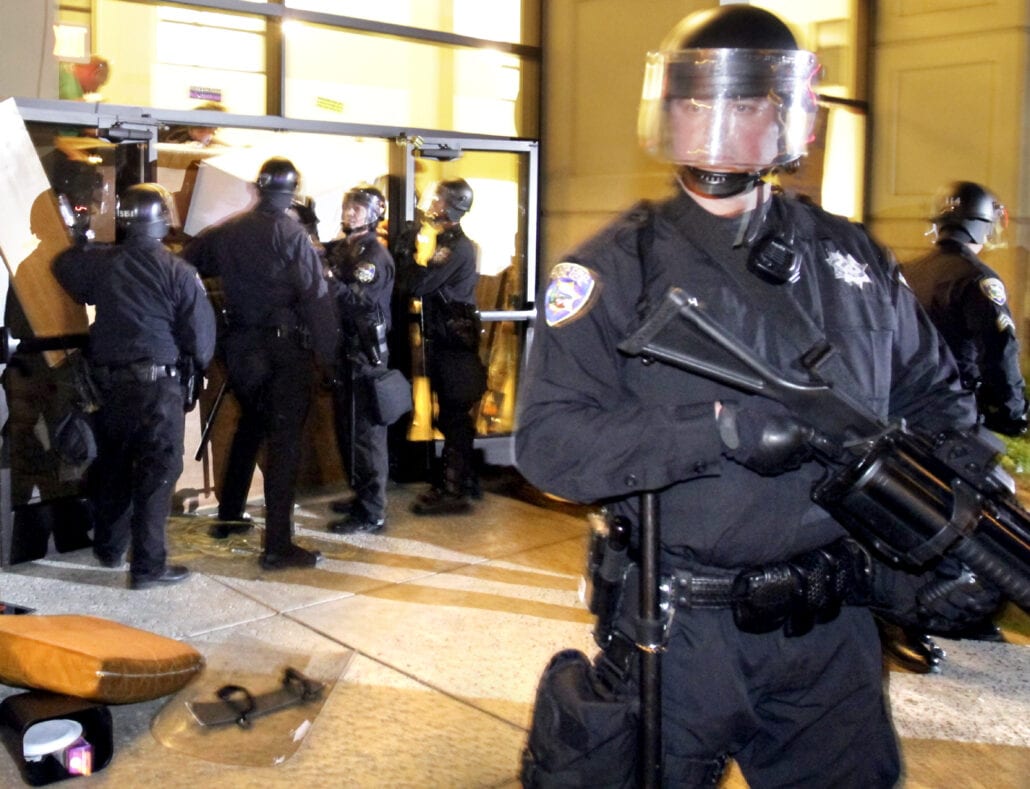
Photo by Shmuel Thaler/Santa Cruz Sentinel
IT WAS A MIRACLE
“That first night we did hold the police back. It was a miracle,” Adams recalls. “We stacked couches just so, with a metal filing cabinet. Somehow, they locked into place in a way that the police couldn’t move them. It was surprising because they could have easily stormed the place. They had twenty officers in riot gear and we were able to hold the door with very few people. That was extremely exciting having them retreat.”
“That was the first time I really respected the police department in my life,” says Adams. “They knew they either were going to hurt some people, stay there to fight us off, or were going to have to retreat. We considered it a huge success, a victory. So, then we were there for a number of days on our own, in this big building.”
Penske explains, “My role in the occupation was as the police liaison and that’s why I think they went after me. They knew exactly who I was. I went to police headquarters and talked to them. I was like, “I’ll take your requests to the people in the building. I don’t know what they’re going to say.” I would. And we were like, “No.” And I would tell the police “No, they’re not into it.”
“I was a little unclear,” Penske remembers. “Are they just buying time with me? Are they talking over here with me while they’re planning that SWAT team thing over there?”
Word got out about the occupied building and on the second night hundreds of people had an impromptu party that resulted in minor damage and graffiti. Wells Fargo estimated the damage at $30,000 including a $16,000 janitorial fee.
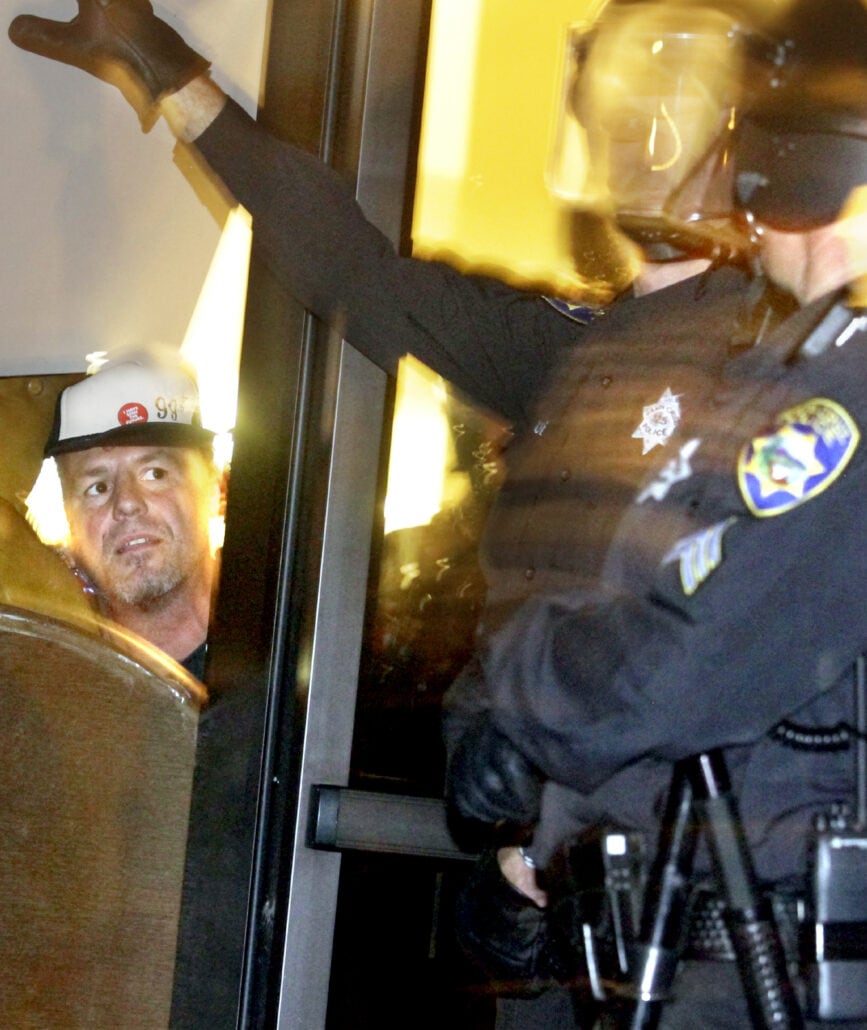
Photo by Shmuel Thaler/Santa Cruz Sentinel
ON A WANTED LIST
Another of the Santa Cruz 11 was local activist Grant Wilson. Unlike Adams and Pocket, Wilson did not participate directly in the occupation, but entered the building with dozens of other onlookers and activists on November 30th. “I was only there for that one time,” he told The Sentinel. Wilson remembers, “Out of the blue, six months later, I get a call from a friend who says, “Did you know you’re on a wanted list?” That was a shock. It might have been the police thinking, “We’ll make an example of these eleven people.”
“I may have been targeted because I was involved in the Last Night New Year’s Eve Parade, where we organized a holiday parade through town without permits,” Wilson conjectures. “The Santa Cruz police sent in undercover agents to our meetings of clowns and jugglers planning this family-focused event. (2005) We discovered those police and we outed them. We took pictures of them. We made it very public. I would say probably on some level we embarrassed the police. And they might have thought, “Let’s pick Grant Wilson because he’s someone that’s a bit on our radar. And we’ll make an example of him.””
Wilson added, “That’s how they picked the eleven. I think it was very random. It was a little bit more of the Keystone Cops thing where they didn’t really have information.”
The Santa Cruz 11 were Brent Adams, Franklin Alcantara, Bradley Stuart Allen, Alex Darocy, Desiree Foster, Becky Johnson, Cameron Laurendeau, Robert Norse, Edward Rector, Gabriella Ripley-Phipps and Grant Wilson.
Wilson elucidates, “The whole process of the legal system and how it operates was very sobering, and also very informative. It wasn’t necessarily me or the other Santa Cruz 11, it was other court cases that would come up when I had to be there by 8:00 AM on a Wednesday morning. There would be four other cases that would go before the judge. Watching those things unfold was often quite unsettling and tragic; watching some person who clearly had mental health issues, who probably had some childhood trauma and could not quietly respect authority. So that person is then getting sent back to jail for another six months. Just watching tragedies unfold or snowball into these even bigger tragedies was really painful to witness.”

Photo by Shmuel Thaler/Santa Cruz Sentinel
PUNISHMENT BEFORE TRIAL
Grant Wilson looks back, “I think of Brent (Adams) and the three others who had to go to court fifty or sixty times! And totally messing up those people’s lives; their jobs and housing. Childcare was one of my jobs at the time and there was a Santa Cruz police officer whose son or daughter was in the preschool. And they said, “I don’t want this accused criminal with my kid.” So, I lost that job.”
Grant Wilson’s court-appointed public defender was Elizabeth Caballero. “I would say almost 95% of people who come before the court are already trauma informed,” estimates Caballero. “If they haven’t already suffered trauma before they got to court, they definitely have trauma after court. There’s no doubt about it. It’s a very powerful thing to point a finger and make an accusation that somebody committed a crime. When you label it a crime it means your liberty is taken away if the allegation is proven. Which means you could lose your house, family, job, healthcare and you could be placed in a box and be warehoused for years.”
The youngest of the Santa Cruz 11 – Desiree Foster – was nineteen at the time and attempted suicide due to stress related to being arrested and facing felony charges, combined with personal economic struggles and illness in her family.
“The whole thing is a pressure cooker,” says Caballero summing up the court system. She added that the judicial process in this case was a form of punishment before trial.
Brent Adams says his life was completely upended by the legal battle; “My life was ruined, because it was more than sixty times in court in a two-year phase.” Adams adds, “I looked at all twenty hours of the police video footage and seeing the list of people that they went after, it’s clear they didn’t even look at their twenty hours because you can easily identify the people who were responsible for breaking into the building.”
Later it was apparent that some SCPD surveillance footage had not been provided to attorneys defending the Santa Cruz 11 and in May, 2012 Santa Cruz County Superior Judge Paul Burdick imposed a $500 sanction against the District Attorney’s office for not providing the material, as required by law.
Adams also explains, “There’s a guy who we believed was an FBI or other type of informant. He’s the one person that during the building occupation was detained for interacting with cops outside. They finally let him go and he was the biggest guy planning this event! He was not one of the people who were prosecuted for this bank building takeover.”
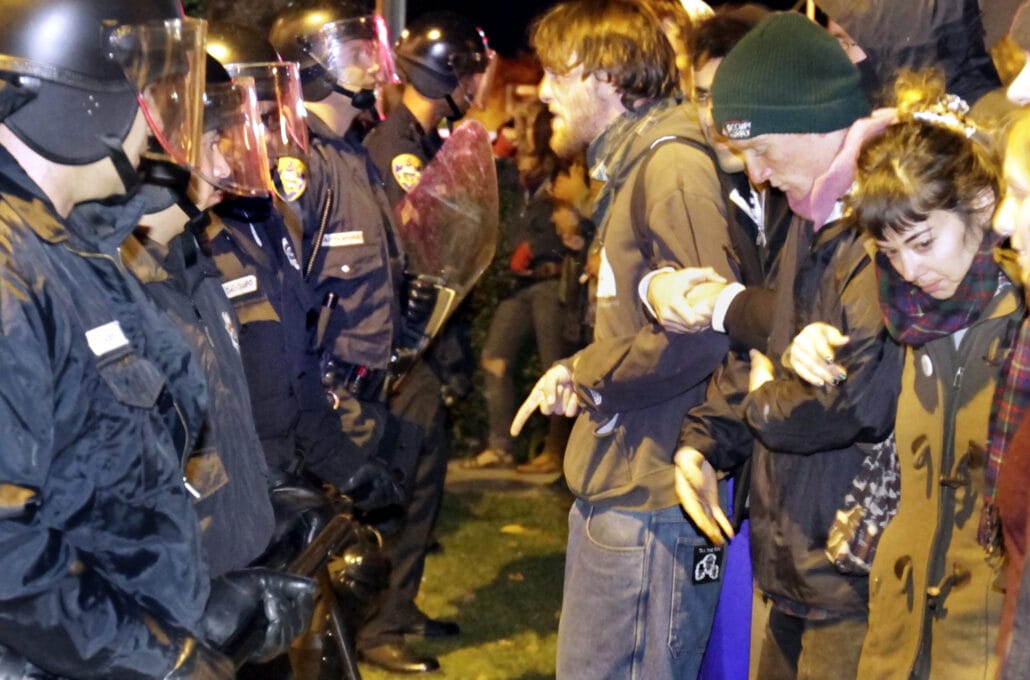
Photo by Shmuel Thaler/Santa Cruz Sentinel
TRAUMATIZED PLEA DEAL
Penske Pocket explains the legal drama: “Three times we were scheduled to go to trial and something would happen right before the trial. That was traumatic. I definitely felt stuck, traumatized and depressed for so many years and confused about what was happening. And then it was right before the third trial and they offered us this plea deal to plead to a misdemeanor trespass and pay $7,000 each in restitution. We went out of the courtroom and all my supporters surrounded me saying, “Take it, take it. This is really good.”
Pocket eventually agreed to the deal, but still regrets she didn’t first consult with the three other remaining Santa Cruz 11 defendants.
“One of my big regrets is that I didn’t say to the others, “Hey, I want to take this. What do you all think?” And trusting that the court is going to wait half a day or a couple hours while we decide. But I felt pressured by my supporters. I felt really scared. We were in that process together for three and a half years and I wish I’d taken that time.”
Brent Adams agrees, disappointedly, “We had an agreement between the last four of us that we would not plead, we would not succumb to it. And in the end, they all plead guilty without telling me. My lawyer said, “We’re in trouble. We have to plead.” And I’m like, “No. We’re not going to.” She goes, “Brent, you’re the last one.” And if I was the last one, I would have definitely done time. In the end, there was no solidarity.”
THIS IS MY PROPERTY
Gene Sharp’s 1973 three-volume treatise – “The Politics of Nonviolent Action” – lists 198 examples of nonviolent direct action. Number 173 is “Nonviolent Occupation” which Sharp explains, “…may be used after a nonviolent invasion or a nonviolent land seizure… Nonviolent occupation may involve technical trespass and the violation of other laws.”
In Santa Cruz the three-day occupation of a vacant bank received mixed reviews. However, many did support the sentiment that the Santa Cruz 11 had been overcharged by the District Attorney and that their charges should be dropped. At the time Mayor Don Lane stated, “I was surprised by the conspiracy charges.”
Overall, concerns about commandeering unused private property seemed to outweigh support for a self-designed community center and homeless shelter. Grant Wilson clarified, “The bank occupation crossed that line, the sacred cow of private property. And that’s not a good idea in America, land of “This is my property. Get off it, even if it’s vacant.”\
Wilson’s public defender Elizabeth Caballero looks back at the bank occupation case ten years ago and describes it as, “strange and difficult.” She explains, “All of that was because people were exercising their First Amendment right to assemble, trying to point out the hypocrisy and institutional wrongness of having a bank sit idle while so many people are in need of that space to be a shelter, or a place to receive food, or some sort of community access point to receive resources.” She pauses and adds, “I totally empathize.”
When the Sentinel recently asked Brent Adams if Occupy activists had overestimated the support they’d garner to establish a homeless shelter in the occupied building Adams exclaims, “I’m still overestimating! Look at the Warming Center and the women’s shelter we’ve created.” He adds, “Look at our attempts at interaction with the government. You’d think they’d say, “Yeah.” But they’re still saying, “No.” We’re still pirates on the seas, renegades!”

Photo by Shmuel Thaler/Santa Cruz Sentinel
ACTIVISM NOW
Penske Pocket has been less confident about activism since 2011. “It’s definitely affected the ways I show up as an activist. In some good ways and a lot of ways I feel pretty sad about. I remember running into the performance artist Beth Stevens and her partner Annie Sprinkle. I told Annie about it and she was like, “That’s ‘gonna be such a good story later!” I was like, “I’m excited for the point where it’s just a good story. Because I’m still kind of in the trauma of it.”
“They definitely succeeded and that was hard; being afraid of being honest that the state repression worked. They got to me. They tore me down,” Pocket recalls. “There’s some shame about that. About how hard it actually was and how it has made me so fearful. It’s made it really difficult to take risks.”
Pocket laments, “I have a lot of judgment about that twenty-five-year-old me, who is just so righteous. She was like, “Yes! This is what needs to happen, this building occupation. Obviously, Santa Cruz sees that empty buildings are a crime while there are people out here on the streets getting soaked and getting sick.” It was a big shattering of my naivete and innocence in a lot of ways.”
HOMELESSNESS IS THE THING
“My ideas have changed since then. Now I’m doing things like this,” says Adams as he turns and points to the building on Felker Street that houses the Footbridge Warming Center he established eight years ago. Adams continues, “I went into the exploration of homelessness. Because what we saw at Occupy Santa Cruz was dozens of people who normally sleep outside. And there was a large argument; “Do these people belong here? Why are they eating our food?” And it turns out that was happening in every city all over the country where there was this argument about, “We’re here for this movement. Why are they here with us?” And then many people said, “They’re on the frontlines and facing these issues personally.” So, it was a real kind of Come-to-Jesus moment that we had to realize that homelessness is the thing. So, that’s what I chose. All the banking debacle and income disparity, all this stuff that we said we were about; really the thing right outside your door is people sleeping outside. And now look at how many more are sleeping outside in 2021.”
Grant Wilson has continued his decades of activism that have included collaborating with the Christic Action Team, Beach Flats Community Garden, Art & Revolution and The Zapatistas. “I’m maybe even more of an activist since then,” he estimates. “It’s added to the depth of my understanding of activism, to see the process of the court system. I think there’s a degree of intention for it to be fair and reasonable, but it certainly is not. I don’t think I’ve held back in my activism. It has not caused me to be especially cautious. There’s now eleven people, most of whom are still in Santa Cruz, who are continuing on their path as activists and advocates for the homeless.”
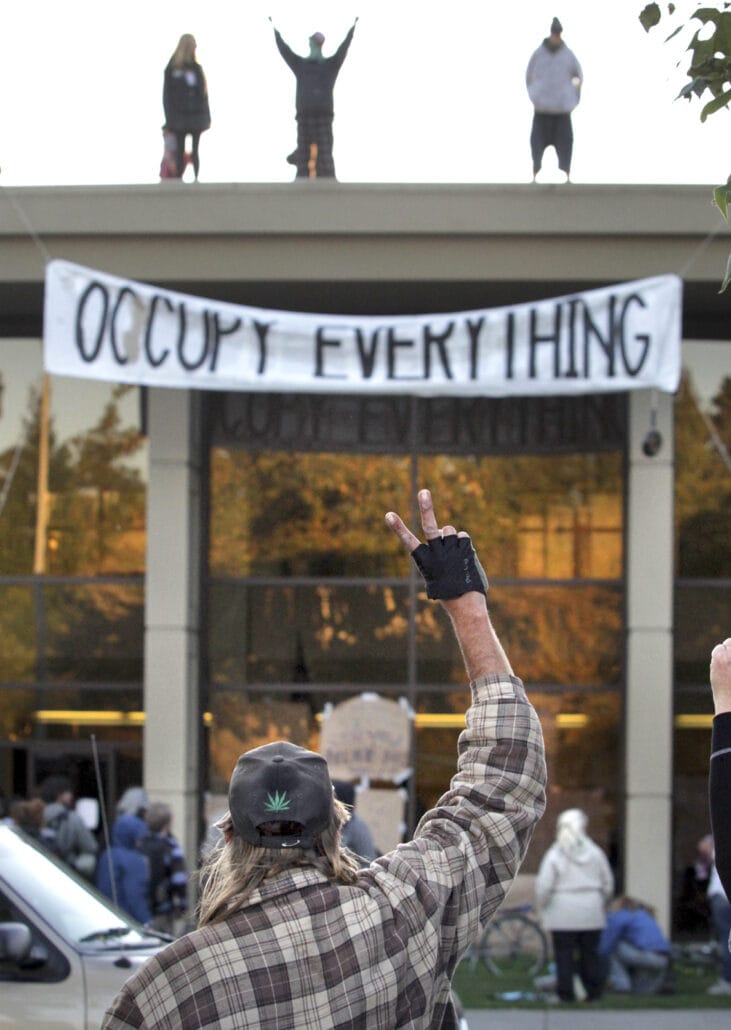
Photo by Shmuel Thaler/Santa Cruz Sentinel
SEE WHAT POWER LOOKS LIKE
“Ten years has gone very fast,” Adams told The Sentinel. “It’s nostalgic for me only as much as it was a national movement we could be very proud of. We stood our ground for many nights. And we built friendships that are still existing. We stayed to the end and I’m proud to have my Occupy badge of honor. At Occupy Santa Cruz, it was about what we could do by ourselves. And finally, together, we got to see what power looks like. When we were together, we could achieve something. What was it we achieved? We didn’t even agree!” Adams laughs fully and adds, “And so I’ve taken that all the way home here. And I know I’ve learned what my power is. What I can do.”
